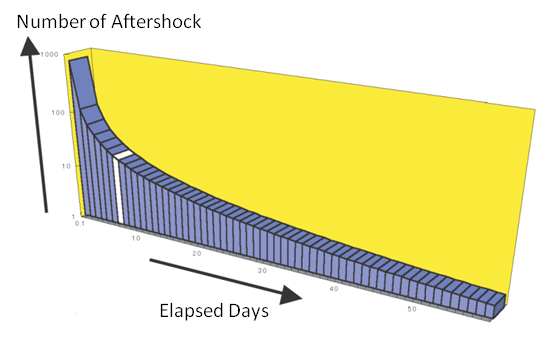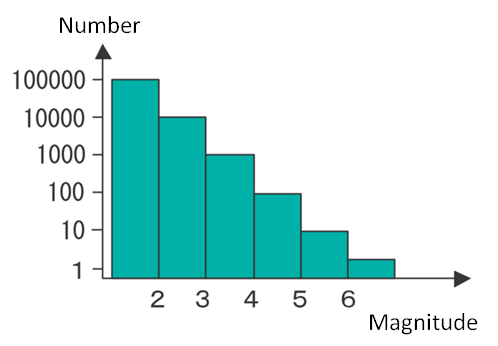The Japan Meteorology Agency announces aftershock outlooks including the following information.
-
Comparison with similar earthquakes in the past
Example: “In comparison with prior earthquakes, the aftershock activity of this earthquake is very high.”
-
Current status of aftershocks
Example: “Although the level of aftershock activity is overall getting lower over time, it is temporarily intensified.”
-
How long we should be cautious of aftershocks
Example: “We should take cautions over the next week.”
-
How strong the highest seismic intensity will be
Example: “We may have aftershock with the seismic intensity of 6 lower on the JMA scale. In some areas, it may be 6-upper.”
-
Things we should consider or watch out for
Example: “In the areas which had a strong shaking by the main-shock, aftershocks may aggravate the damages such as collapse of houses and landslide. Thus, please be cautious about aftershocks, for instance, refrain from entering dangerous zones unless compelling reasons.”
In addition, probability of large aftershocks which may occur within the period of 3 days will be posted as a reference.
There are two kinds of characteristics in aftershocks. We focus on these characteristics, and calculate the probability of aftershocks, and make an aftershock outlook.
One of the above two is that the number of the aftershock is the most right after the main shock but gradually decreases over time.

The other nature is that earthquakes with larger (smaller) magnitudes occur less (more) frequently.

Considering the above two characteristics, we may well describe aftershock generation process as follows. Immediately after the mainshock, aftershocks occur frequently including intense aftershocks; however, their frequency will be lowered over time, and will be settled eventually. The above two natures will be expressed by the statistical equations well-known in seismology, the combination of which enables the forecast of aftershock probabilities. In this way, we are able to calculate the probability of aftershocks that are beyond a certain size in scale in the form of percentage such as “the probability of aftershocks exceeding magnitude-5 within the next 3 days is 30 percent”. “Probability of aftershocks” is calculated in this way.
It is issued when there is a fear that aftershocks may aggravate the damages brought by the main shock. Concretely speaking, the followings are the cases.
- [1] When the mainshock damages are severe. (maximum seismic intensity of the mainshock exceeds an 6-upper on the JMA-scale)
- [2] When the affected areas are expected to be broad (areas recording seismic intensity of 5-lower on the JMA-scale are broad in scope)
- [3] When aftershocks with 1 or greater of seismic intensity on the JMA scale occur very frequently.
The first information is generally issued about a day after the occurrence of the earthquake, after the type of the earthquake is identified as “main-shock type”.
As for inland-earthquakes, it will be announced in every three days for the first seven days, and will be weekly thereafter. As for marine- earthquakes, it will be announced in every three days for the first ten days, and from thereafter it be weekly updates likewise.
Note that aftershock generation process differs between inland and undersea earthquake. As for inlands, the largest aftershocks occur approximately within 3 days from the main shock, and within 10 days as for the undersea which is a little longer.
The probability of getting each number, for instance “1”, on a dice is about 16% (1/6). The probability of 30% that aftershocks with magnitude of 6 or greater occur within 3 days is, therefore, higher than that of getting “1”. Concretely speaking, when JMA issues outlook that probability of aftershocks with magnitude of 6 or greater within 3 days is 30%, such aftershocks actually occur within 3 days 3 times out of 10.
Overall, the number of aftershocks gradually decreases over time, sometimes accompanying large aftershocks. In the case of earthquakes causing some damages, special attentions to aftershocks will be needed for the first seven to ten days (for about a month in the case of aftershocks being active). Generally, it takes a couple of years until activities of aftershocks completely settle.